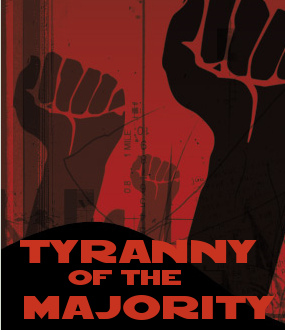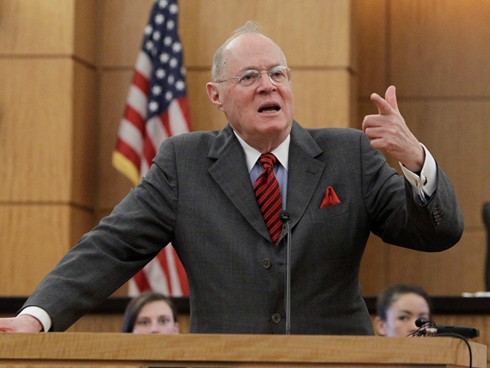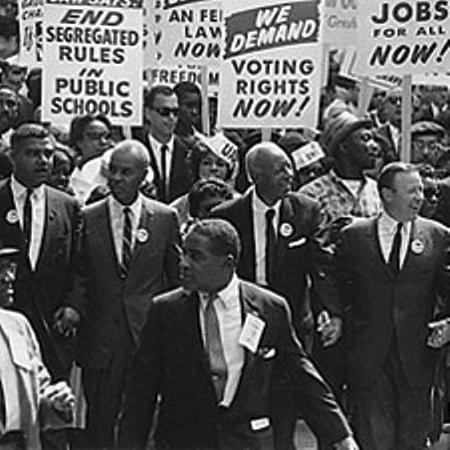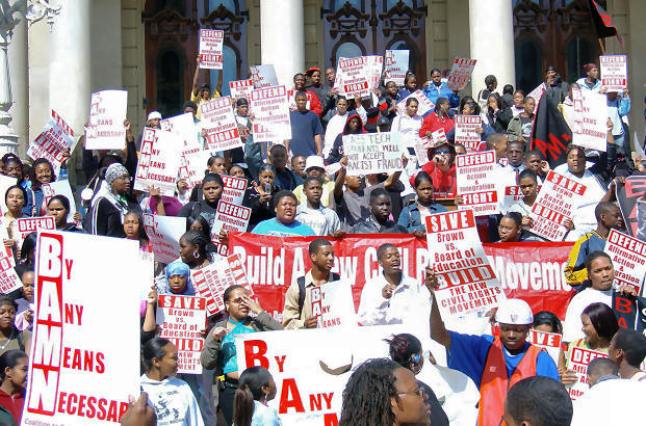
 BY BAR EXECUTIVE EDITOR GLEN FORD
BY BAR EXECUTIVE EDITOR GLEN FORD
April 24, 2014
“Black folks have no rights that white majorities are bound to respect.”
That’s the message from the U.S. Supreme Court, which declared diversity programs an option that white majorities can legally ban. The High Court also safeguards the right of the rich to dominate elections. This week’s ruling shows that the Roberts Court “knows how to serve both majorities of whites and Big Capital, too.”
“Majoritarian rule becomes a crude legal redoubt of white supremacy.”
White majorities have the constitutional right to create laws that selectively lock racial minorities into inferior status. So decreed the United States Supreme Court, in a 6 to 2 vote [8] upholding Michigan’s prohibition against affirmative action in public higher education. Although race-conscious admissions polices remain legally permissible, voters may close the door to such remedies to historical discrimination, at will, as set forth in Justice Anthony M. Kennedy’s controlling opinion: “There is no authority in the Constitution of the United States or in this court’s precedents for the judiciary to set aside Michigan laws that commit this policy determination to the voters.”
In plain English, Black folks have no rights that white majorities are bound to respect.
It’s “a racist decision,” the modern equivalent to the Supreme Court’s 1896 Plessy v Ferguson ruling sanctifying racial segregation, said Shanta Driver [9], lawyer for Detroit-based By Any Means Necessary, the losing party in the case. The decision “makes clear that this Court intends to do nothing to defend the right to equality in politics, opportunity, rights, hopes and aspirations of its Latina/o, black, Native American and other minority citizens” said Driver. “At the very moment that America is becoming a majority minority nation this Court is declaring its intention to uphold white privilege and to create a new Jim Crow legal system.”The circling of black robes around the inviolability of the principle of one person-one vote is a supreme historical irony, given that the Constitution originally counted Black slaves as “three-fifths [10] of all other Persons” for the purpose of apportioning the Congress. White majorities were slim or non-existent in the slave-intensive states, whose reconstruction to electoral “democracy” remains incomplete to the present. Yet, in the waning days of a national white majority, an era projected to end around the year 2043 [11], majoritarian rule becomes a crude legal redoubt of white supremacy.
“This Court intends to do nothing to defend the right to equality.”
Back in 2003, the Supreme Court ruled that affirmative action at the University of Michigan served a compelling public interest in spreading “diversity” in the upper echelons of U.S. society. As I wrote in The Black Commentator [12] at the time, the Court was not addressing Black historical grievances, which had already gone by the legal wayside. Rather, it ruled that the programmatic inclusion of non-whites at elite public universities created benefits for society as a whole. This week’s ruling sweepingly proclaims the right of white majorities (58 percent of “the voters” in a 2006 Michigan referendum) to forgo such benefits, at their pleasure, as have [13] California, Florida, Texas, and Washington.
Affirmative action, as understood by President Lyndon Johnson and Dr. Martin Luther King Jr., is long dead [12]. It is “diversity” as public policy that was mortally wounded by the Roberts court, this week. Diversity is now an option that can be outlawed by white voter fiat – which will no doubt occur at a quickening pace given that majorities of whites believe they are the main objects of discrimination in American life. A 2011 study [14] by researchers at Harvard and Tufts Universities, titled “Whites See Racism as a Zero-Sum Game That They Are Now Losing,” showed whites “believe that anti-white bias is more prevalent than anti-Black bias” and that “Black progress is linked to a new inequality” – at white expense.
It is difficult to imagine a greater mass cognitive dissonance. The racism that has always been endemic to the U.S. drove whites crazy, and majorities of them remain nuts – dangerous people, capable of…anything. The High Court has given its benediction to the righteousness of their insanity.
“Diversity is now an option that can be outlawed by white voter fiat.”
 The judicial system is, of course, even more consistent in building a body of legal precedent for the supremacy of money in electoral politics, than of the primacy of majorities – the two being antithetical in principle. In practice, however, the U.S. Supreme Court knows how to serve both majorities of whites and Big Capital, too. The post-Civil War Supreme Court elevated corporations to personhood, smoothing the way for the Gilded Age, and plunged Blacks into the depths of Constitutionally-sanctioned Jim Crow, simultaneously creating all-white electorates and one-party rule by the most backward elements of the bourgeoisie in Dixie.
The judicial system is, of course, even more consistent in building a body of legal precedent for the supremacy of money in electoral politics, than of the primacy of majorities – the two being antithetical in principle. In practice, however, the U.S. Supreme Court knows how to serve both majorities of whites and Big Capital, too. The post-Civil War Supreme Court elevated corporations to personhood, smoothing the way for the Gilded Age, and plunged Blacks into the depths of Constitutionally-sanctioned Jim Crow, simultaneously creating all-white electorates and one-party rule by the most backward elements of the bourgeoisie in Dixie.
In Michigan, where white majority opinions and prejudices are deemed sacred by the High Court and a racist referendum is dubbed a “Civil Rights Initiative [15],” more than half of Black voters have been effectively disenfranchised under the dictatorship of state-imposed emergency financial managers. In jurisdictions like Detroit, Flint and Benton Harbor, where Blacks are the bulk of the population, majorities mean less than nothing; they are dangerous, and must be politically neutered for the general public good, while Wall Street picks Detroit’s bones in a federal bankruptcy court.
Where racism is endemic, all kinds of things are possible – and constitutional.
BAR executive editor Glen Ford can be contacted at Glen.Ford@BlackAgendaReport.com
Source URL: http://blackagendareport.com/content/supreme-court-white-majorities-%C3%BCber-alles
Links:
[1] http://blackagendareport.com/category/african-america/reverse-racism
[2] http://blackagendareport.com/category/african-america/plessy-v-ferguson
[3] http://blackagendareport.com/category/african-america/diversity-programs
[4] http://blackagendareport.com/category/african-america/any-means-necessary
[5] http://blackagendareport.com/category/african-america/affirmative-action
[6] http://blackagendareport.com/category/political-economy/corporate-personhood
[8] http://www.nytimes.com/2014/04/23/us/supreme-court-michigan-affirmative-action-ban.html?ref=us
[10] http://en.wikipedia.org/wiki/Three-Fifths_Compromise
[11] http://usnews.nbcnews.com/_news/2013/06/13/18934111-census-white-majority-in-us-gone-by-2043?lite
[12] http://www.blackcommentator.com/49/49_cover.html
[13] http://www.nytimes.com/interactive/2013/06/24/us/affirmative-action-bans.html
[14] http/ase.tufts.edu/psychology/sommerslab/documents/raceInterNortonSommers2011.pdf
[15] http://en.wikipedia.org/wiki/Michigan_Civil_Rights_Initiative
[16] mailto:Glen.Ford@BlackAgendaReport.com
STATEMENT FROM THE BAMN PLAINTIFFS ON THE SUPREME COURT’S RULING IN SCHUETTE V COALITION TO DEFEND AFFIRMATIVE ACTION, INTEGRATION AND IMMIGRANT RIGHTS AND FIGHT FOR EQUALITY BY ANY MEANS NECESSARY
April 22, 2014
DETROIT — Shanta Driver, national chairperson of BAMN, the Coalition to Defend Affirmative Action, Integration and Immigrant Rights and Fight for Equality By Any Means Necessary, was also the attorney who argued for minority political rights at the Supreme Court in Schutte v BAMN. Her comments on today’s decision follow:“Today’s Supreme Court decision upholding the ban on affirmative action in Michigan is a racist decision. It is this Court’s Plessy v Ferguson. The decision of the Court today makes clear that this Court intends to do nothing to defend the right to equality in politics, opportunity, rights, hopes and aspirations of its Latina/o, black, Native American and other minority citizens. At the very moment that America is becoming a majority minority nation this Court is declaring its intention to uphold white privilege and to create a new Jim Crow legal system.

- Young marchers from BAMN protest outside Michigan Gov. Rick Snyder’s home near Ann Arbor, MI against his takeover of majority-Black cities in Michigan through PA 4, the first Emergency Manager Act.
This decision allows a white majority electorate, state legislature, state courts and other political and legal entities to pass laws that create inequality in political rights and most immediately, access to higher education. The new civil rights and immigrant rights movement is the only force that can restore progress in this society and stop the resegregation of higher education. It took the last civil rights movement to overthrow the old Jim Crow, and the young leaders of the new civil rights/immigrant rights movement will defeat the new Jim Crow.
The aim of state bans on affirmative action is to encourage public universities to discriminate against the right of Latina/o, black and Native American applicants to attend this nation’s most prestigious public universities. Any university that claims to use a holistic admissions policy cannot turn a blind eye to the effects of institutional racism and inequality in K-12 education, and must consider the real-life experiences and obstacles that its minority applicants face. BAMN encourages any Latina/o, black and Native American student who applied to the University of Michigan, deserves to be at the University of Michigan, and was rejected, to contact BAMN and fight for your equal right to attend the university.”
Constitution Check: Has the Supreme Court ended affirmative action at the college level?
THE STATEMENTS AT ISSUE:
“Today, by permitting a majority of the voters in Michigan to do what our Constitution forbids, the Court ends the debate over race-sensitive admissions policies in Michigan in a manner that contravenes constitutional protections long recognized by our precedents.”
– Justice Sonia Sotomayor, in a dissenting opinion on Tuesday as the Supreme Court upheld Michigan’s voter-approved ban on the use of race in selecting students to enter the state’s public colleges and universities. The ruling came in the case of “Schuette v. Coalition to Defend Affirmative Action.”
“A majority of the Justices not only overturned a decision by the U.S. Circuit Court of Appeals for the Sixth Circuit, which had struck down Michigan’s measure, but also made clear that they would reject any similarly argued challenge to the bans on race-conscious admissions adopted by voters in Arizona, California, Nebraska, Oklahoma, and Washington.”
– Peter Schmidt, Washington reporter for The Chronicle of Higher Education, in an online story on Tuesday about the scope of the Supreme Court’s decision.
WE CHECKED THE CONSTITUTION, AND…
Racial equality disputes, it is fair to say, have been a source of deep and growing constitutional controversy within the Supreme Court for at least the past decade, and the basic notion of “affirmative action” has been increasingly moving to the center of disagreement. The court, however, has just raised the prospect that this approach may be facing new and significant narrowing, at the least.
While the use of race as a key factor in shaping public policy and government programs has been used for hiring public workers and placing government contracts, its most frequent use – and its most controversial – has been in the field of education. Indeed, the effort to rid the public schools of racial segregation, in the wake of the Supreme Court’s 1954 and 1955 rulings in the case of Brown v. Board of Education, led directly to the creation of the concept of “affirmative action” as a remedy for ongoing racial bias. (Some historians suggest that it may actually have had its origins in an order by President Harry Truman in 1948, desegregating the U.S. military.)
At the college level, the Supreme Court applied the idea in 1977 to uphold voluntary use of race as a factor in selecting students to attend the University of California’s medical school, in the decision of California Regents v. Bakke. But the continuation of that approach never was far from controversy, and when the Supreme Court reopened the issue in 2003, in two cases from the University of Michigan (one in the law school, one for undergraduate admissions), it was not at all clear that it would survive fully intact.
It did survive, but only by a 5 to 4 vote, in the case of Grutter v. University of Michigan – the law school case. There were clear warning signs: the four dissenters argued that the admissions program was a thinly veiled version of a quota system. Among those dissenters were Justices Anthony M. Kennedy, Antonin Scalia and Clarence Thomas, who would continue on the court after several changes in its membership.
Those three, in fact, formed the core of a five-Justice majority four years later that struck down a voluntary public school affirmative action plan in a case involving the Seattle school district. They were joined by then-new members, Chief Justice John G. Roberts, Jr., and Justice Samuel A. Alito, Jr. That was the clearest sign yet that “affirmative action” was definitely in deepening trouble constitutionally. Chief Justice Roberts reinforced that impression, with a now-famous comment in one of the opinions for the majority: “The way to stop discrimination on the basis of race is to stop discriminating on the basis of race.”
Only Justice Kennedy, who made clear at that time that there were some situations in which race could still be used in defining education policy, kept the Seattle decision from going further.
Then, in 2013, the Supreme Court returned to “affirmative action” at the college level for the first time in ten years and, once more, there were fairly common assumptions that this approach to racial equality in education would again be in peril. This was the case of Fisher v. University of Texas, involving a white applicant’s rejection for admission at the university’s flagship Austin campus.
This time, Justice Kennedy wrote the lead opinion. It spoke for a 7-1 majority (with only Justice Ruth Bader Ginsburg dissenting). But the ruling totally supplanted the Grutter decision from a decade earlier, and created a new form of constitutional analysis that almost certainly would make it more difficult for public universities to justify the use of race in their admissions policy.
The ultimate outcome of that case remains uncertain, because it is currently going through a new round in a federal appeals court, the Fifth U.S. Circuit Court of Appeals. That court held a hearing on the case on November 18, and is now pondering a decision.
That case appears most likely to be the next test of the Supreme Court’s view on “affirmative action” at the college level.
But two days ago, the Supreme Court fundamentally altered the outlook for the use of race in educational policy with its decision in another Michigan college case, Schuette v. Coalition to Defend Affirmative Action. In a 6-2 decision (with Justice Elena Kagan not taking part), the court ruled – for the first time – that the voters of a state may bar their public officials from any use of race in admissions to public colleges.
Although the court’s lead opinion, written by Justice Kennedy, stressed that the court was not ruling on whether race-based admissions policies themselves were unconstitutional, the ruling created an opening for states to scuttle “affirmative action.” It said explicitly that issues of racial policy in America can be handled quite competently at the polling place.
Almost certainly, the skepticism that the Kennedy opinion expressed in that opinion about the role of the judiciary in overseeing America’s debate about racial issues will be studied by the appeals court judges as they prepare to write their ruling in the new round in the University of Texas case.
In fact, on Tuesday, lawyers for the University of Texas brought the new decision to the appeals court’s attention, to try to persuade those judges that the Supreme Court, in fact, had not undermined the constitutional premises of “affirmative action.” The challengers to Texas’s admissions policies very likely will take a different view.
Lyle Denniston is the National Constitution Center’s adviser on constitutional literacy. He has reported on the Supreme Court for 55 years, currently covering it for SCOTUSblog, an online clearinghouse of information about the Supreme Court’s work.
Recent Constitution Daily History Stories
Podcast: The affirmative action controversy at the Supreme Court














Awesome website you have here but I was wondering if you knew of any
community forums that cover the same topics discussed in this article?
I’d really like to be a part of online community where I can get advice from other experienced people that share the same interest.
If you have any recommendations, please let me know.
Kudos!